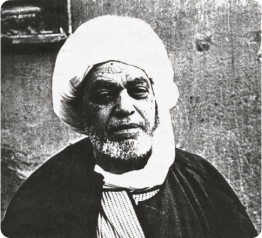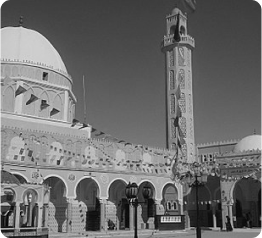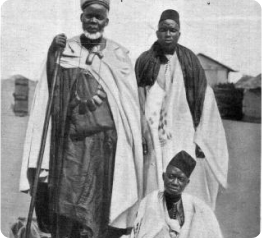Muhammad al-Hafiz al-Shinqiti
By Zakariya Wright
Muhammad al-Hafiz b. al-Mukhtar b. al-Habib (1759-1830) is credited with first introducing the Tariqa Tijaniyya in Mauritania, whereby it was introduced into sub-Saharan West Africa. He became the preeminent instructor (muqaddam) of the Tijaniyya in Mauritania after spending years in the company of Shaykh Ahmad Tijani in Fes. Besides his mastery of Sufism, he was a jurist and hadith scholar of great renown.
Sidi Muhammad al-Hafiz hailed from the noble Idaw ‘Ali people in Mauritania, who trace descent from Muhammad Ibn Hanafiyya, a son of Ali b. Abi Talib. His father, Mukhtar b. Habib (d. 1806) was also an Islamic scholar, and particularly distinguished for his mastery of the art of calligraphy. His maternal grandfather, Muhammad al-Alawi, was the chief judge (qadi) among the important Trarza region of Mauritania in the mid-1700s. Sidi al-Hafiz was not the only scholar among his siblings, and two brothers, Muhammad Sa’id and Muhammad al-Amin were also famous scholars. The same was true of his brother-in-law, Muhamdi b. Abd Allah al-Alawi, known as “Baddi,” who authored the most complete biography of Sidi al-Hafiz, called Nuzhat al-Mustam’ wa-l-lafiz fi manaqib al-shaykh Muhammad al-Hafiz (1832).
Shaykh Muhammad al-Hafiz began his Islamic education with the Qur’an, and memorized the entire Holy Book by the age of seven. Following the death of his grandfather, he continued his studies in jurisprudence (fiqh) with his grandmother— herself a learned scholar who taught him the Alfiyya of Ibn Malik, the Risala of Ibn Abi Zayd and the Mukhtasar of Sidi Khalil. After the death of his grandmother, he traveled to study grammar (nahw) among other sciences with the learned Faqih, Abd Allah b. Ahmaddan (d. 1815). Sidi Ahmaddan was also a shaykh of the Shadhiliyya Nasiriyya, but there is no evidence that Sidi al-Hafiz took the Shadhili wird at this time. He next studied the Qur’anic sciences, logic (mantiq) and theology (‘aqida) with Hurma b. Abd al-Jalil (d. 1827) and then completed his study of jurisprudence (fiqh) with Abd Allah b. Ahmad b. Mahham b. al-Qadi (d. 1826). Continuing in the tradition of a traveling student in search of sacred knowledge, he next went to study with Abd Allah b. al-Hajj Ibrahim (d. 1818), a celebrated scholar in Mauritania who had studied in Fes and who had become a friend of the Moroccan Sultan, Mawlay Muhammad b. Abd Allah. Sidi al-Hafiz spent six years with Sidi Abd Allah, studying Prophetic traditions (hadith), legal principles (usul al-fiqh) and rhetoric (ilm al-bayan). He also married his teacher’s daughter. The companions of Shaykh Tijani in Fes remarked that even after his submission to Shaykh Tijani, Sidi al-Hafiz maintained the utmost respect for his previous teachers; and for Sidi Abd Allah in particular.
Indeed, it was following Sidi Abd Allah’s example that Sidi al-Hafiz embarked on his journey seeking knowledge in Fes. But there was also a more immediate reason for his journey to Fes. Sidi al-Hafiz had made persistent supplication while performing Hajj to be united with a perfected spiritual master. As he was circumambulating the Holy House in Mecca, an unknown man approached him to tell him that Shaykh Ahmad Tijani was to be his spiritual master. After learning the identity of this mysterious Shaykh from a group of Moroccan pilgrims, Sidi al-Hafiz traveled to Fes to meet him. He spent four years with Shaykh Tijani in Fes, from 1800-1804/5. The ijaza he received, still preserved among his descendants in Mauritania, was dictated by Shaykh Tijani and written in the hand of Muhammad b. Mishry, the close companion of Shaykh Tijani and author of Kitab al-Jami’.
Before leaving to return home, Shaykh Tijani advised him, “Do not seek to appear (before the people) until Allah makes you appear.” For the first year after his return, Sidi al-Hafiz thus practiced the Tariqa with great discretion as he taught the Islamic sciences, neither informing others of the Tariqa nor of his appointment as propagator (muqaddam). Then he received a surprise visit from an ascetic famous for his visionary encounters with Khidr, the mystical instructor of Moses as mentioned in the Qur’an. The ascetic told him to give him the wird he was hiding. With this sign, Sidi al-Hafiz began to speak openly of the Tariqa Tijaniyya even as he continued teaching the classical Islamic sciences. His teachings attracted a great many students and, besides his credentials as a Sufi shaykh, he particularly renowned as a distinguished scholar of hadith, possessing a highly desirable chain (isnad) of transmission through Salih al-Fulani in Medina. He wrote a commentary on the Alfiyya discussing the rules of hadith transmission. He was also known for his teaching of jurisprudence and grammar. His instruction in tasawwuf emphasized the Kitab al-Hikam of Ibn ‘Ata Allah in addition to Tijani sources. Sidi al-Hafiz discouraged conflict between Sufi orders and advised his disciples not to disrespect the followers of other Sufi paths, saying “Do not ask him who follows another Sufi order to abandon his litany and do not seek to dampen his enthusiasm for it. Tell him instead that all the litanies (awrad) are paths that lead to Allah.” Following the advice of Shaykh Tijani, Sidi al-Hafiz’s own Sufi instruction differed from existing Sufi practice in Mauritania by its absence of spiritual retreat (khalwa) and a de-emphasis of talismanic sciences.
Through Muhammad al-Hafiz the Idaw ‘Ali quickly became the principle propagators of the Tijaniyya in West Africa. The “Hafiziyya” tradition was marked by many great scholars after the passing of Sidi al-Hafiz. The book of Ubayda ibn Muhammad al-Saghir al-Tashit, Mizab al-Rahma al-Rabbaniyya fi al-Tarbiya bi al-Tariqa al-Tijaniyya (1851), is considered a masterful synthesis of the Tijani legacy left by Muhammad al-Hafiz. It describes the essence of the Tariqa as gratitude (shukr) to Allah and details a methodology of spiritual training (tarbiya) through the three stages of Islam (submission), Iman (faith) and Ihsan (spiritual excellence). The most famous disciple of Muhammad al-Hafiz was Mawlud Fal, who is credited with the expansion of al-Hafiz’s teachings outside of the Idaw ‘Ali. Mawlud Fal was from the Id-Ayqub, a people of Mauritania famous for their expertise in jurisprudence. He became a close disciple of Shaykh al-Hafiz and eventually married his sister. He left for Fes in 1815 hoping to meet Shaykh Tijani in person, but arrived just after his passing. The Tijani notables of Fes nonetheless renewed his ijaza originally given him by al-Hafiz. He studied closely with the son of Ali Harazim, who instructed him in the practice of khalwa and other supererogatory litanies not transmitted to him by Muhammad al-Hafiz. After his study in Fes, Mawlud Fal traveled widely throughout West Africa. During his travels, he appointed many teachers who themselves helped spread the Tariqa all over Africa. Thus ‘Abd al-Karim b. Ahmad al-Naqil (the first shaykh of al-Hajj Umar Futi) became one of his important muqaddams in Futa Jallon; Mudibu Ahmad Raji received an ijaza from Mawlud Fal to spread the Tariqa in Northern Nigeria; and Wad Dulayb spread the Tariqa in the Sudan under the silsilah of Mawluf Fal.
The “Hafiziyya” branch of the Tijaniyya also played an important role in securing support for the Jihad of al-Hajj Umar among the Moroccan Tijani scholars. Al-Hajj Umar kept in close contact with the Hafiziyya zawiya in Mauritania even after his training with Muhammad al-Ghali. Once, when the Sokoto Sultan Muhammad Bello requested permission from him for the prayer hizb al-bahr and the book Jawahir al-Khams, al-Hajj Umar responded that he himself could not give such permission, but that he would request it from the Hafiziyya zawiya in Mauritania. To this end, al-Hajj Umar sent his elder brother Alfa Ahmad, who had his own ijaza renewed by the Hafiziyya zawiya.
Even in the twentieth century, the Hafiziyya tradition played a large role in shaping the careers of Tijani scholars. One of al-Hajj Malik Sy’s most important initiations into the Tariqa was through the son of Mawlud Fal, known as al-Shaykh. Shaykh Ibrahim Niasse’s most significant early ijaza besides that from his father was from al-Hajj Abdullahi Wuld al-Hajj, a renowned representative of the Hafiziyya tradition who had been seeking the spiritual flood (fayda) of Shaykh Ahmad Tijani for many years before recognizing it in the person of Shaykh Ibrahim Niasse.
Sources: Abdallah Dedoud Ould Abdellah, “Passage au Sud,” in Triaud and Robinson, La Tijaniyya: une confrérie muslumane à la conquête de l’Afrique (2000); Ahmad Sukayrij, Kashf al-Hijab; Muhammad al-‘Arabi b. Sa’ih, Bughyat al-Mustafid.




